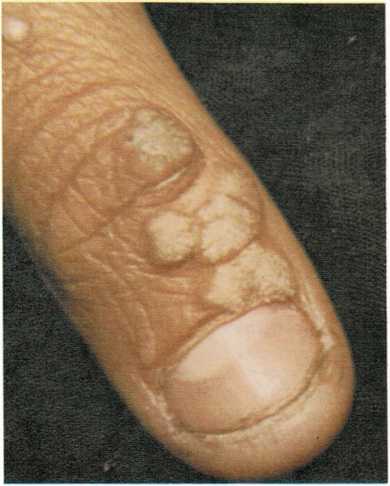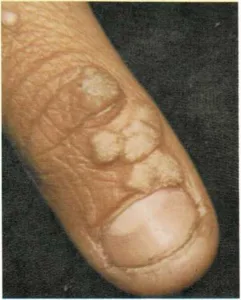Warts – Whooping Cough
Warts are small, hard growths on the skin. They tend to appear in
groups of three or four, but they may appear singly or in large numbers.
Most warts grow on the backs of the hands and on the soles of the feet.
Warts on the soles of the feet are called
plantar warts. Warts are caused by a papilloma virus. Caution children
against “picking” at warts. This may spread the virus and increase the
number of warts.
There are several effective and painless methods for removing warts.
These methods include blistering agents, liquid nitrogen, salicylic acid
plasters, special solutions, or electrosurgery. Your doctor should be
consulted.
Some doctors prescribe suggestion therapy, a safe method that you can
try at home. The power of suggestion therapy performed by the child
under a doctor’s direction will often “cure” warts in a few months. Most
warts disappear without treatment of any type within two years. Plantar
warts, however, rarely disappear without treatment, [a.m.m.]
Wetting. Persistent wetting after a child is 4 to 5 years old is
called enuresis. Most incidents of enuresis occur at night, and are
accompanied by occasional wetting in the

Aside from the discomfort caused if they grow at the base of a
fingernail or toenail, warts do not seem to have any harmful effect on
a child’s general health.
daytime. If your child has enuresis, consult your doctor.
Some cases of enuresis are caused by a defect in the urinary tract or a
chronic urinary infection. Your child may complain of painful urination,
difficulty in starting or stopping urination, discolored urine, or
increased frequency of urination.
Sometimes the problem is emotional, particularly if wetting occurs after
the child has been toilet-trained for several months or years. Usually,
some difficulty in relations with others is involved—especially with
parents, but also with teachers, brothers, sisters, or playmates. One of
the most common causes for a child’s bedwetting is the arrival of a new
baby.
Do not threaten, punish, ridicule, or plead with a child to stop
wetting. These actions may increase the child’s anxiety and make wetting
more persistent. The child is not doing it deliberately and usually
feels bad about it already. You can help most by discovering what is
distressing the child. Is the child in too high a grade level at school?
Is the child trying too hard to compete? The child may feel like a
failure in social and school relationships. Build up a feeling of
self-confidence. The child may need more of your time and attention.
When anxiety and tensions are reduced, wetting may stop.
Most enuretic children have no urinary tract defect and are not
emotionally disturbed. Frequently, the child is a deep sleeper and may
not be awakened by the feeling of bladder fullness. Bedwetting may also
be a family pattern. During the day, these children urinate often.
Drug therapy has been used in treating enuresis, with varying success.
Conditioning devices (a pad attached to an alarm which rings as soon as
the child begins to wet the bed) have also been successful. But they
should be used only in selected instances with children who are old
enough to understand what is being attempted and who are willing to
cooperate, [m.g.]
See also Urinary disturbances
Whooping cough (pertussis) is a contagious disease that is caused by
bacteria. It begins like an ordinary cold. The child has a
runny nose, a slight fever, and a dry cough. After a few days, long
spells of coughing occur that are usually worse at night. The child may
begin to whoop—a long drawing in of breath that sounds like
crowing—after a spell of coughing. The coughing spells may also cause
vomiting.
If you suspect that your child has whooping cough, call your doctor.
Also, be sure to call your doctor if your child has been exposed to
whooping cough and has not been immunized against it.
Whooping cough is spread by a spray of droplets from the child’s mouth
or nose. A child who has w\’hooping cough should use tissues to cover
the mouth and nose when sneezing and coughing. The used tissues should
be burned or disposed of in a safe place. The child should be isolated
from other family members.
Whooping cough is communicable from about seven days after exposure to
three weeks after coughing begins. If your child has been exposed to
whooping cough and is not immune, your doctor wall probably recommend
that the child be quarantined for 14 days after exposure. One attack
usually provides immunity. There is also a whooping cough vaccine.
Whooping cough vaccine is usually given along with diphtheria and
tetanus vaccines in a single shot, commonly called a DPT shot. Children
6 years old or less are given two shots about two months apart, and a
third shot about a year after the second. Ideally, these shots are given
during infancy. A booster, usually as a DPT shot, is given when the
child enters school. There are certain contraindications to the use of
pertussis vaccine, and it is not given to some children. (See
[Diphtheria] for guidelines about immunization with DPT.)
All infants, except those with contraindications, should be immunized
against whooping cough. The disease can be fatal to any child. The death
rate is, however, far higher for infants less than a year old who have
not been immunized. Immunization is so effective and widespread that the
disease is less common, but it is still potentially serious for the
unimmunized child, [h.d.r..] Jr.
See also Communicable diseases; Diphtheria; Immunization; Shots

